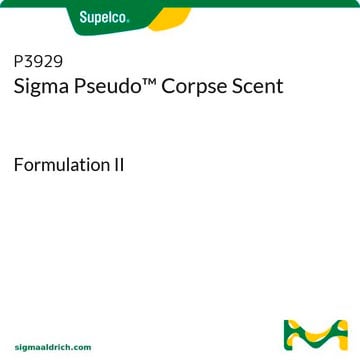52063
Cadaverine
analytical standard
Synonym(s):
1,5-Diaminopentane, 1,5-Pentanediamine, Pentamethylenediamine
About This Item
Recommended Products
grade
analytical standard
Quality Level
assay
≥96.5% (GC)
96.5-103.5% (T)
shelf life
limited shelf life, expiry date on the label
technique(s)
HPLC: suitable
gas chromatography (GC): suitable
impurities
≤1.5% water
refractive index
n20/D 1.457-1.459
n20/D 1.458 (lit.)
bp
178-180 °C (lit.)
mp
14-16 °C (lit.)
density
0.873 g/mL at 25 °C (lit.)
application(s)
cleaning products
cosmetics
flavors and fragrances
food and beverages
personal care
format
neat
SMILES string
NCCCCCN
InChI
1S/C5H14N2/c6-4-2-1-3-5-7/h1-7H2
InChI key
VHRGRCVQAFMJIZ-UHFFFAOYSA-N
Looking for similar products? Visit Product Comparison Guide
General description
Application
- Food samples using an electrochemical disposable screen-printed device consisting of two working electrodes in array mode and reversed-phase high-pressure liquid chromatography with fluorescence detection (HPLC-FLD).
- Biological matrices using reversed-phase liquid chromatography separation coupled to electrospray ionization-ion trap tandem mass spectrometry (HPLC-ESI-ITMS/MS).
Recommended products
signalword
Danger
hcodes
Hazard Classifications
Eye Dam. 1 - Skin Corr. 1B
Storage Class
8A - Combustible corrosive hazardous materials
wgk_germany
WGK 3
flash_point_f
143.6 °F - closed cup
flash_point_c
62 °C - closed cup
Choose from one of the most recent versions:
Already Own This Product?
Find documentation for the products that you have recently purchased in the Document Library.
Customers Also Viewed
Our team of scientists has experience in all areas of research including Life Science, Material Science, Chemical Synthesis, Chromatography, Analytical and many others.
Contact Technical Service










